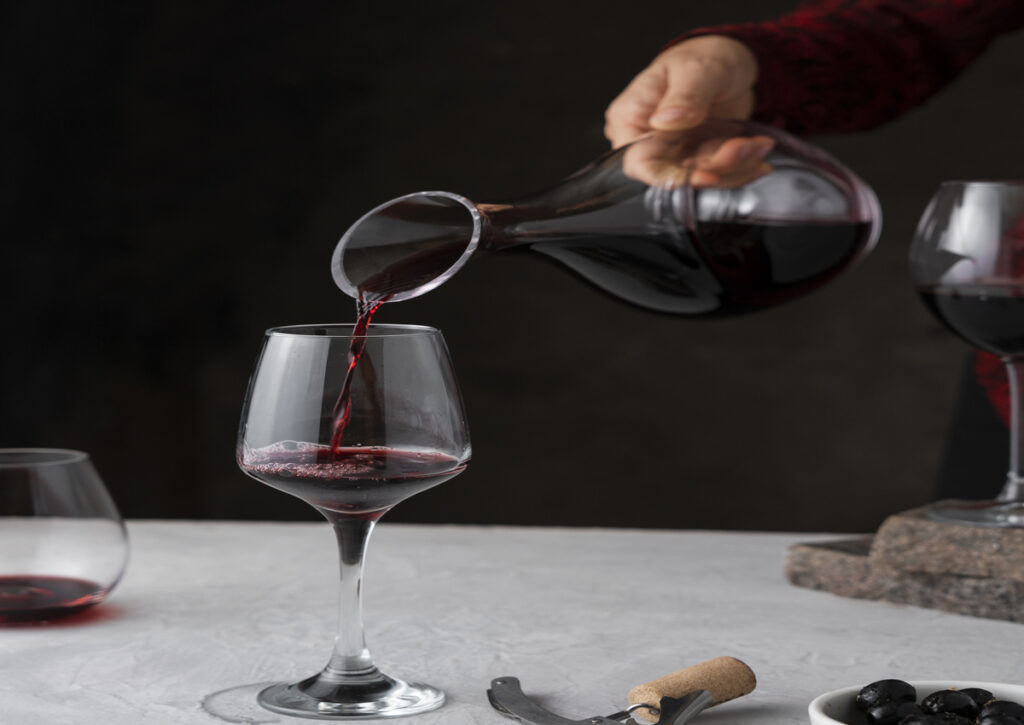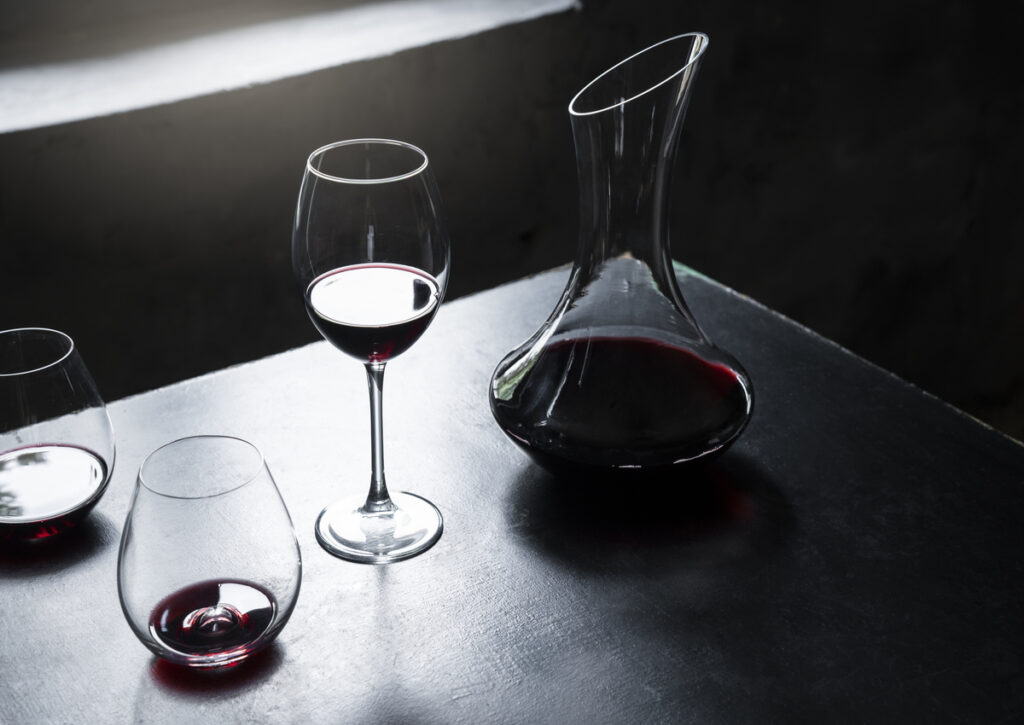
Unlocking the best flavor from a great bottle of wine shouldn’t be too hard. At PLWT Napa, we know that most of the time, our wine is purchased, opened, and enjoyed without much thought. Usually, there isn’t a step between opening and drinking. However, in certain cases, using a decanter can significantly enhance the wine’s flavor.

Decanting a Wine
To decant wine, you transfer it from its original bottle into the decanter, taking care not to disturb the sediment at the bottle’s bottom. This process requires some practice but becomes easier over time.
How to Decant Wine
Decanting wine is a delicate process that requires a bit of care and patience. Here’s a simple guide to help you understand how to do it properly.
Steps to Decant Wine
- Prepare the Bottle: If your wine bottle has been stored horizontally, take it out and place it upright for an entire day before you start decanting. This helps the sediment settle at the bottom of the bottle.
- Open the Bottle: Use a corkscrew to carefully open your wine bottle.
- Position the Bottle: Tilt the neck of the bottle towards the decanter, keeping the bottom of the bottle below a 45-degree angle to prevent the wine from gushing out and disturbing the sediment.
- Pour the Wine: Pour the wine into the decanter steadily. Watch for any sediment approaching the bottle’s opening—using a light or candle can help you see better.
- Pause if Needed: If you see sediment near the neck, stop pouring, tilt the bottle back to upright, then start again.
- Finish Pouring: Complete the pouring process, leaving about half an ounce of wine with the sediment in the bottle.
Important Considerations
Not all wines benefit from extended exposure to air. Some wines improve after a few hours in a decanter, while others may oxidize and spoil, leading to an unpleasant taste.Decanting can be done up to four hours before you plan to drink the wine. There’s little risk of over-decanting most wines, but aim to enjoy or recork the wine within 18 hours.

How Long Should You Decant Your Wines?
Decanting wine can greatly enhance its flavor by removing sediment from older red wines and softening the taste of younger wines. However, it’s crucial to know how long to decant your wine for the best results.
Red Wines
Red wines typically need between 20 minutes and two hours of decanting to reach their peak flavor. Here’s a breakdown based on the body of the wine:
Light-Bodied Red Wines
Light-bodied reds, like Gamay, Grenache, Zinfandel, and Pinot Noir, only need about 20 to 30 minutes of decanting.
Medium-Bodied Red Wines
Medium-bodied reds, such as Merlot, Malbec, Tempranillo, Cabernet Franc, and Barbera, should be decanted for 20 minutes to an hour.
Full-Bodied Red Wines
Full-bodied reds, including Cabernet Sauvignon, Petit Sirah, Monastrell, and Nebbiolo, require between one to two hours of decanting.
Generally, most red wines benefit from at least 15 minutes of decanting to allow reductive qualities to dissipate. Afterward, an additional 15 to 30 minutes helps mellow any sharp aromas, and by the 60-minute mark, the tannins will have softened significantly.
White and Rosé Wines
Most white wines and rosés don’t require decanting. However, if they exhibit reduction, which can happen if the wine has been deprived of oxygen for too long, decanting can help. You’ll know a wine is reduced if it lacks aromas or smells off, like rotten eggs, burnt rubber, or garlic.
For reduced white wines and rosés, decanting for up to 30 minutes, though usually 15 minutes is sufficient, will restore their fruity scents.
When to Decant Wine
If you’re unsure whether to decant a wine, smell or taste it directly from the bottle. If it tastes too bitter, lacks aroma, has minimal fruity notes, or smells like rotten eggs or a struck match (due to hydrogen sulfide), decanting can help aerate the wine and remove any sediment.
What is a Wine Decanter?
A wine decanter is a glass vessel into which wine is slowly poured from its original bottle. The process of decanting is more than just transferring wine to another container; it’s about carefully pouring the wine to avoid disturbing the sediment at the bottom. This sediment can be found in many aged wines and can affect the taste if mixed with the liquid.

Benefits of Decanting Your Wine
- Sediment Removal: When wine ages, especially older red wines and vintage ports, sediment forms at the bottom of the bottle. This solid material isn’t harmful but can taste bitter and make the wine’s flavors less vibrant. By slowly pouring wine into a decanter, you can separate the clear liquid from the sediment, ensuring a better tasting experience.
- Oxidation enhances the wine’s aroma and flavor, making it more enjoyable for wine
- Aeration: Decanting wine exposes it to oxygen, causing various beneficial changes. drinkers. Wines with harsher tannins benefit from this process as oxygen softens the tannins, making the wine smoother. Additionally, some wines might have unpleasant smells, like struck matches or rotten eggs, which dissipate once exposed to air.
- Improving Reduced White and Rosé Wines: Reduced wines, which haven’t had enough exposure to oxygen, can develop off-putting smells like eggs and sulfur. Although decanting is usually associated with red wines, reduced white and rosé wines can also improve with a short decanting period, regaining their liveliness and flavors.
- Bringing Wine to the Proper Serving Temperature: If your wine has been stored at a lower temperature, decanting can help warm it up to the ideal serving temperature. This process can enhance the wine’s flavors and overall drinking experience.
- Removing Broken Cork Pieces: Sometimes, the cork might break when opening a bottle of wine. Decanting allows you to pour the wine slowly, leaving any broken cork pieces behind in the bottle neck. This ensures that you get a clean pour without any cork fragments in your glass.
Understanding the Difference Between a Decanter and a Carafe
Both decanters and carafes are common in the world of wine, but they serve different purposes. A decanter is designed with a shape that helps to aerate your wine, enhancing its flavor by allowing it to breathe. In contrast, a carafe is simpler in design and is mainly used for serving wine, without the aerating benefits.
Serving a Decanted Bottle of Wine
When you decant wine, even though it’s now in a separate vessel, it’s important to keep the original bottle and its cork (or screw top). If you’re serving the wine to guests, it’s a good idea to display the original bottle and cork alongside your decanter. The bottle label provides
information about the wine to your guests, and the cork can be used as a stopper if you need to return the wine to the bottle for later use.
Conclusion
Decanting wine is more than just a sophisticated ritual; it’s vital to enhancing the overall wine experience. By understanding the purpose and techniques of decanting, you can unlock the full potential of your wine, ensuring each sip is as enjoyable as possible. Knowing how long to decant can make a significant difference, whether you’re dealing with a light-bodied red, a full-bodied red, or a reduced white or rosé.
Decanting helps to remove sediment, aerate the wine, and bring out its best flavors and aromas. Moreover, it ensures your wine reaches the optimal serving temperature and keeps it free from any unwanted cork pieces. By incorporating decanting into your wine routine, you’ll be able to appreciate the nuances and complexities of your favorite bottles, making each glass a memorable experience. So, the next time you uncork a bottle, consider giving it some time in a decanter to savor its richness.
FAQs: Purpose of Decanting a Wine
-
Why should I decant wine?
Decanting wine helps remove sediment, enhances flavors through aeration, and can improve the taste of both red and some white wines. It also allows the wine to reach the proper serving temperature and can filter out any cork pieces.
-
How long should I decant my wine?
The decanting time varies based on the type of wine. Light-bodied red wines need 20-30 minutes, medium-bodied reds require 20 minutes to an hour, and full-bodied reds benefit from one to two hours. Reduced white and rosé wines typically need 15-30 minutes.
-
How can I tell if my wine needs decanting?
If your wine tastes too bitter, lacks aroma, or smells like rotten eggs or burnt rubber, it could benefit from decanting. This process will aerate the wine and improve its overall flavor and aroma.
-
What is the difference between a decanter and a carafe?
A decanter is designed to aerate wine, enhancing its flavors and aromas, while a carafe is primarily used for serving wine without the aeration benefits. Decanters typically have a wider base to allow more surface area for oxygen exposure.
-
Can I decant white and rosé wines?
Most white and rosé wines don’t require decanting. However, if they exhibit reduction (lack of aroma or off smells), decanting for 15-30 minutes can help restore their fruity scents and improve their taste.














